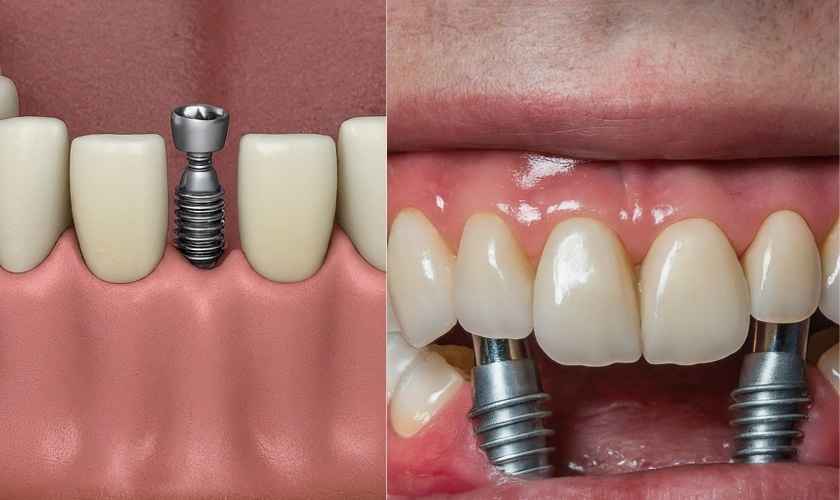All About Dental Sense
All About Dental Sense
Blog Article
The Main Principles Of Dental Sense
Table of ContentsThe 10-Second Trick For Dental SenseDental Sense Things To Know Before You BuyThe Greatest Guide To Dental SenseIndicators on Dental Sense You Need To Know
are medical gadgets operatively implanted right into the jaw to recover an individual's ability to chew or their appearance. They provide support for artificial (phony) teeth, such as crowns, bridges, or dentures. When a tooth is lost because of injury or illness, a person can experience problems such as rapid bone loss, faulty speech, or modifications to eating patterns that cause discomfort.Dental implant systems are composed of an oral implant body and dental implant joint and might likewise include an abutment fixation screw. Dental veneers cost. The dental implant body is surgically inserted in the jawbone instead of the tooth's origin. The oral implant joint is normally connected to the implant body by the abutment addiction screw and expands via gum tissues into the mouth to support the connected synthetic teeth
(https://www.avitop.com/cs/members/dentalsense1.aspx)Framework of The Oral Implant System choosing oral implants, talk to your dental provider about the potential advantages and risks, and whether you are a prospect for the procedure. Points to think about: Your overall health and wellness is an essential element in identifying whether you are a good prospect for dental implants, the length of time it will require to heal, and the length of time the dental implant may remain in location.
Cigarette smoking might impact the recovery procedure and lower the long-lasting success of the dental implant. The healing procedure for the dental implant body may take numerous months or longer, throughout which time you typically have a short-term abutment in place of the tooth. the oral implant procedure: Thoroughly adhere to the oral health instructions provided to you by your oral supplier.
Some Ideas on Dental Sense You Should Know
Implant failing can lead to the requirement for an additional medical procedure to repair or change the dental implant system. Brings back the capacity to chew Restores cosmetic look Assists maintain the jawbone from diminishing as a result of bone loss Preserves the health and wellness of the surrounding bone and gum tissues Aids maintain surrounding (nearby) teeth steady Improves quality of life Damage to bordering natural teeth during dental implant placement Injury to the surrounding tissues during surgery, such as sinus perforation Injury during surgery (for instance, fracture of surrounding jawbone) Inadequate function, such as seeming like the teeth do not attack together generally A feeling that the tooth is loosened or turning in location arising from an abutment screw loosening Implant body failure (looseness of the dental implant body) due to systemic infection, which may be more probable in people with unrestrained diabetes as a result of local infection in bone and periodontals sustaining the implant body because of postponed healing, which may be more probable in clients who smoke Difficulty cleaning the gum tissues around the implant, resulting in poor oral health Untreated periodontal disease Post-surgical pins and needles because of nerve impingement or damages Always notify health care suppliers and imaging professionals that you have oral implants prior to any kind of magnetic resonance imaging (MRI) or x-ray treatments.
FDA is not familiar with any kind of negative events reported for MRI or x-ray procedures with oral implants. Dental implants systems are normally constructed from products that follow global consensus standards of the International Organization for Standardization (ISO) or ASTM International. These criteria have details of what makes a safe product.

An oral implant is a structure that replaces a missing tooth. With screw-like devices, the surgeon inserts a dental implant right into the jawbone, and it functions as an anchor for a man-made tooth, called a crown. A gadget called an abutment links the synthetic tooth to the oral implant. The crown is customized to fit the individual's mouth and match the shade of their teeth.
Dental Sense Can Be Fun For Everyone
Some individuals are not qualified for dental implant surgical procedure. It is for oral doctors to operate people with: severe illnessuncontrollable metabolic diseasebone or soft cells condition or infectionIf these issues are solved, an individual can have the surgery. In, dental specialists abstain from running on individuals with: If people with any of the above undertake dental implant surgical treatment, there is a greater danger of the dental implant stopping working.

Oral implant surgical treatment is a tailored procedure. It's not the very same for everyone. The adhering to gives a general summary of what you can anticipate your dental professional, dental specialist, periodontist or prosthodontist to do: Put the dental implant surgically. Provide you time to heal. Connect the post and last crown, bridge or denture.
Next off, your cosmetic surgeon will thoroughly place the dental implant right into your jaw. Your specialist will certainly reposition your periodontals and close the incision with stitches. If your implant is near the front of your mouth, your dental expert will certainly make a temporary tooth for you to use until you recover. In this way, you will not have a void in your smile while you recoup.
The 45-Second Trick For Dental Sense
Your supplier can tell you what to anticipate in your scenario. Throughout the recovery phase, your jawbone should fuse to the dental implant. This procedure, called osseointegration, is crucial for security and long-term success. This procedure can take anywhere from 3 to 9 months. In some cases, it might take longer.
Once your dental implant heals, your dentist can connect the abutment (little adapter message) and your last restoration (crown, bridge or denture). This typically takes news about one hour to complete and may need a 2nd minor surgery. You shouldn't feel any pain throughout your dental implant treatment since your supplier will utilize drug to numb your gum tissues.
Report this page